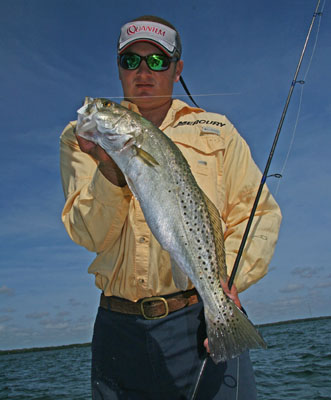Live Bait the Key to Consistent Catches

Photo by David A. Brown |
By CAPT. BILL MILLER
For overall consistency and productivity, you can't beat live bait for most inshore pursuits. My live baits of choice are scaled sardines (whitebait), live shrimp and pinfish. I try to have all of them in my bait well if I can. Threadfin herring (greenbacks) will also work, but their weakness and low endurance makes them a lesser preference.
Whitebait is my No 1 choice, although at times, it can be hard to find and catch. Castnetting is the primary method, but some may lack the interest and/or ability to throw a net.
Shrimp is my second choice for live bait. They're commonly available at most bait shops, but you do have to budget for the extra cost. For many, that's a fair trade-off to avoid getting wet and dirty from castnet duties. Leaving the dock with bait in your well is also a psychological benefit.
Next on my bait list are hand-size pinfish – because you never know when you might run into cobia, tarpon, shark, grouper, etc. Catch these hardy baits with a trap set near the edge of a grass flat or by anchoring along the edge of the flat and using a small piece of squid on a No. 10 hook. Smaller pinfish can also be used the same as the whitebait for trout, reds, snook, etc.
Whatever baitfish I'm catching, I like the bigger ones when I head offshore because I’m usually going for bigger fish like grouper, snapper, amberjacks or bigger kings. Larger whitebait and threadfins hang around bridges so I’ll look there first. I will also use sabikis around channel markers and bridges for bigger baits.
Whitebait Roundup
The most common places to find whitebait are over grass flats and around bridges. On the flats, bait schools often dimple the surface like rain, but also watch for sea gulls and pelicans diving on this food source. Ease in slowly, quietly anchor or drop your Power Poles and coax the baitfish into net range by chumming.
Options include dry chum, available at bait shops in zippered plastic bags, or jack mackerel and wheat bread. Mixing either of these recipes with sea water forms a smelly paste that forms a scent trail when scattered across the grass flat. When the baitfish gather in the chum, toss the net and load the live well.
Another way to find bait is the rodeo technique. Ride slowly over the grass and when you see bait throw your net. If no other boats are in the area this works fine. If there is other boats anchored and chumming, do not rodeo. It will scare and push the bait around and off the flats and irritate other anglers.
For catching bait on the flats, a ½-inch stretched mesh cats net with standard weight will do the job. A 6-foot net will work but I prefer an 8- to 10-foot net for the flats.
Another good place to catch white bait is around bridges and big channel markers. The bait can be found raining on top or it can be found with your depth recorder. Look for a cloud of bait in the water column. Anchoring and chumming will work here but water depth and tide movement make it harder. I like to ride around the marker or the bridge pilings and when I see the bait marking on my screen, I throw the net.
For deeper water, use a 1-inch stretched. You may gill a few baits in the larger mesh, but the net will sink faster so fewer baits will escape. Bait schools are harder to hit in deeper water, so use a 10- to 12-foot net, which will catch more on each throw. In either case – flats or deeper water – handle your baits carefully so they justify all the effort by lasting for a full day of fishing.
For weekly fishing reports, hot tips, catch photos and lots of angling resources, visit www.billmiller.com. For fishing charters in the Tampa Bay area, call (813) 363-9927.

